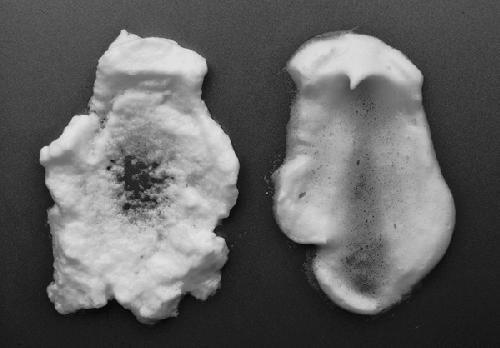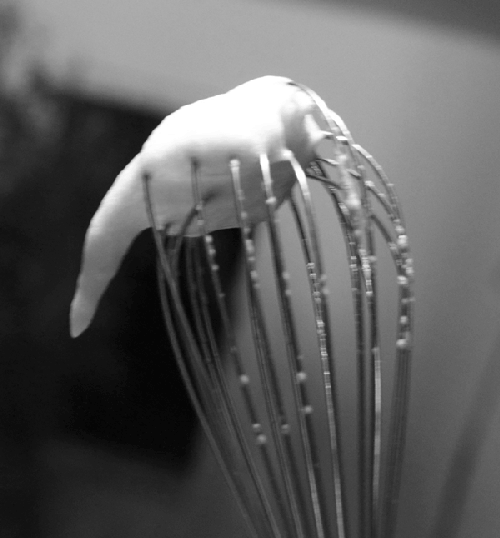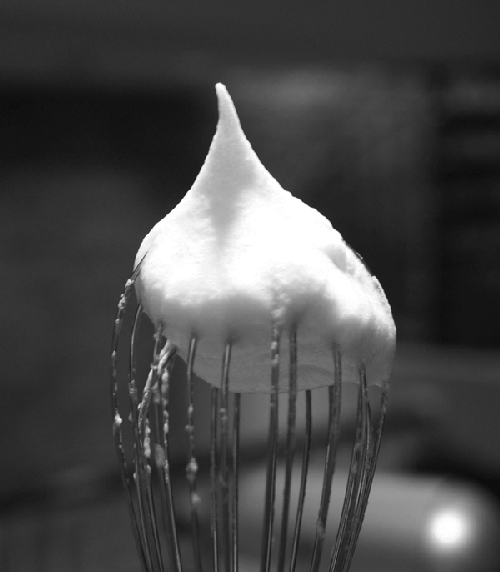Mechanical leaveners work by trapping air within a
liquid—usually by whipping egg whites, egg yolks, or cream—or by generating steam from water
present in the food.Unlike biological or chemical leavening methods, which rely on the chemical makeup of
the food to generate air, mechanical rising techniques rely on the physical properties of
the food to hold air. Because of this, mechanical leaveners can’t just be added to a dish
without considering the impact of the moisture or fat that they also add, which can throw
off the ratios between ingredients such as flour and water or sugar and fats.
Note:
“Cream the butter and sugar” has nearly three million exact-phrase matches on Google,
and plenty is written about the microscopic air bubbles that the sugar crystals drag
through the butter when creamed. When you see a recipe call for creaming butter and sugar,
use room-temperature butter—it needs to be plastic enough to hold on to the air bubbles
but soft enough to be workable—and use an electric mixer to thoroughly combine the
ingredients until you have a light, creamy texture.
1. Egg Whites
Whisked egg whites are the Styrofoam of the culinary world: besides acting as space
fillers in cakes, waffles, and soufflés and as “insulators” in desserts like lemon
meringue pie, when overcooked, they taste about the same as Styrofoam, too. All metaphors
aside though, egg whites are much more forgiving than many cooks realize. With a little
attention spent on understanding the chemistry and a bit of experimentation, egg-white
foams are easy to master.
Note:
A foam is a mixture of a solid or liquid surrounding a
dispersion of gas; that is, the gas (usually air) is dispersed
through the liquid or solid, not in a single big cavity. Bread is a solid foam; whipped
egg whites are a liquid foam.
The key to understanding egg whites is to understand how foams themselves work.
Whisking egg whites turns them into a light, airy foam by trapping air bubbles in a mesh
of denatured proteins. Since regions of the proteins that make up egg whites are
hydrophobic—literally, water-fearing—they normally curl up and form
tight little balls to avoid interacting with the water. But when whisked, those regions of
the proteins are slammed against air bubbles and unfold, and as more and more proteins are knocked
against an air bubble, they form a layer around the bubble and essentially trap it in the
liquid, creating a foam that’s stable.
Oils—especially from egg yolks or any trace oils present in the whisking bowl—prevent
egg whites from being whisked into a foam because they’re also able to interact with the
hydrophobic sections of the proteins. Water and sugar don’t interfere with the formation
of protein-based foams for the same reason.
Once the air bubbles are encapsulated by the proteins in the egg white, it takes quite
a bit of effort to get them to break. Exposing the whites to any oil before whisking is a
problem; even a trace amount of fat from a small amount of stray egg yolk will interfere
with the creation of the foam. But once the eggs are whisked, they’re much more resilient.
Try this experiment: whisk an egg white to soft peaks, then add ½ teaspoon (5g) olive oil
and continue to whisk. It might surprise you how long it takes before the oil starts to
noticeably interact with the foam, and even then, that the foam remains mostly
stable.
Definitely not plastic. Copper bowls work best; a clean stainless steel or glass
bowl is fine. Plastic is chemically similar enough to oil that oil molecules stick around on it
and are impossible to completely remove. Whisking egg whites in plastic bowls doesn’t
produce as good a result because there’s enough oil lingering on the surface of the bowl
to interfere with the development of the foam. (Of course, it’s fine to whip cream in a
plastic bowl; more fat isn’t going to interfere with the fat-based foam
structure.) When you use a copper bowl, trace amounts of copper ions interact with the proteins
in the egg whites to make a more stable foam. It’s not a subtle effect: egg whites
whisked in copper bowls are definitely easier to work with. Copper bowls are expensive,
but if you find you’re whipping up egg whites a lot, it’s probably worth breaking down
and spending $40 on one. For more occasional use, most of us have stainless steel or glass bowls on hand, and
those are fine. While these materials won’t help with the egg-white foam by adding
copper ions, they also won’t hold on to problematic fats. Cream of tartar is commonly
used as a chemical buffer—any time you see a recipe calling for egg whites to be whisked
and you’re using stainless steel or glass, “auto-complete” it with a pinch of cream of
tartar (⅛ teaspoon [½g] per egg white). Don’t use cream of tartar in a copper bowl, though;
it’ll interact with the copper. Try an experiment: whisk three whites in a plastic bowl, three whites in a stainless
steel or glass bowl, and, if you should happen to have a copper bowl, three whites in a
copper bowl. Take a spoonful of the resulting foams and smear it on a cookie sheet to
compare the difference between the foams.
Egg whites whisked to stiff peak in a stainless steel bowl (left) and
a copper bowl (right), smeared on a cookie sheet to show the difference in
texture.

|
1.1. Meringues
Egg whites, when whisked and combined with
sugar, turn into a sweet, airy mixture suitable for folding into heavier bases, bringing
a lightness and sweetness. Of course, sugar and egg whites are pretty good on their
own—meringue cookies are nothing more than egg whites and sugar that have spent a little
time in the oven. The sugar isn’t just for taste, though; it helps stabilize the
egg-white foam by increasing the viscosity of the water present in the foam, meaning
that the cell walls in the foam remain thicker and are thus less likely to collapse. Net
result? The meringue is better able to support the weight of anything you add into the
foam.
When whisking, think about the goal. If you’re trying to whisk air into the food
to create a foam, such as whipped cream or whipped egg whites, whisk—preferably by
hand!—in an up-and-down circular motion, catching and trapping air. If you’re trying
to mix ingredients together without necessarily adding air, whisk in a flat circular
motion. This is especially important for dishes like scrambled eggs, where
incorporating air actually reduces the quality.
I prefer whisking things by hand. Why? Electric beaters won’t work in as much air
before the foam is set because of the motion of the beaters. Also, when whisking,
avoid tiny little stirring motions. This is true for stirring almost anything, whether
you’re holding a whisk or a spoon. Sautéing vegetables? Either get in there like you
mean it, or don’t touch them; just let them sit so that they brown. Likewise, when
whisking foams, get in there like you mean it and whisk some air in there!
Once you’ve got the motion down, how do you know when it’s done? It depends on the
recipe. If it calls for soft peaks, the foam should still be supple and pliable, but
if it calls for firm or stiff peaks, the foam should hold and set its shape; stiff
peaks should be firmer and glossier than firm peaks.
When it comes to folding egg whites into a batter, as long as you’re using a whisk
or spatula—not an electric mixer—you can be a bit more vigorous than conventional
wisdom suggests.
Soft peak stage: the foam stays on the whisk but the peak falls
over.

Firm and stiff peak stages: the foam maintains its shape and can be
sculpted.
